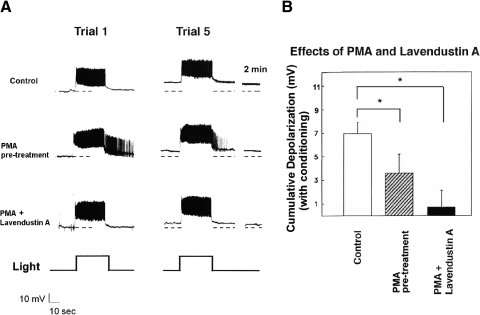Fig. 3.
Phorbol 12-myristate, 13-acetate ester (PMA) exposure partially occludes conditioning-produced cumulative depolarization of type B photoreceptors and lavendustin A blocks the remainder of cumulative depolarization. A, top trace: control-condition B cell (10−7 M acetone solution) showed about 9-mV depolarization following in vitro conditioning (middle trace). Pretreatment of B cell with the protein kinase C (PKC)-activator PMA (10−7 M) reduced cumulative depolarization due to in vitro conditioning. This PMA-exposed B cell showed only about 5 mV of depolarization 2 min following the 5th conditioning trial (bottom trace). Introduction of lavendustin A into a PMA-exposed B cell eliminated PMA-resistant cumulative depolarization of the B cell. This cell showed only about 1.5 mV of depolarization following conditioning. PMA-exposed type B photoreceptors also showed greater steady-state light responses, compared with those of solvent-control cells. B: summary data for B cells conditioned in the presence of PMA, the combination of lavendustin A and PMA, or acetone control. PMA-exposed B cells showed significantly less depolarization than that of controls. B cells conditioned in the presence of both PMA and lavendustin A showed significantly less depolarization than that of PMA-exposed cells.

